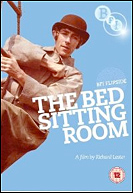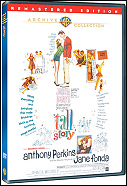
*
Who was the Steve Jobs of 1602? The equivalent of Bill Gates? Hugh Jackman, Eli Manning, Madonna? The celebrities of the day — whoever was monopolizing the front pages, or their equivalent — are long forgotten. Yet we keep hearing about that enigmatic scribe from Stratford-upon-Avon, who wrote all those plays. Or maybe didn't write all those plays. And who hobnobbed with the queen, or didn't. Yes, it's old Will Shakespeare who is once again on our minds, our stages, and even on our wide-screen television. In this case, we have Roland Emmerich's Anonymous [Columbia]. The folks out in movieland have taken those centuries-old rumors — did he? or didn't he? — and latched onto one Edward de Vere, just then the Earl of Oxford. Did he write the plays and let some illiterate bumpkin take credit? This is not an argument I'll jump into; I would guess that Will wrote the plays, but I haven't done decades of research on the subject and am glad to stay out of it. (I can, however, authoritatively speak about stuff written — or not — by the likes of Irving Berlin and Jerry Herman.)
| |
 |
|
| Cover art for "Shakespeare In Love" |
The newly-released "Anonymous" arrives at the very same moment as the Blu-ray edition of the 1998 Best Picture winner Shakespeare in Love [Lionsgate]. This gives us a different series of conjectures on the life of the Bard. Whether the thing is at all realistic, let alone likely, is something else; it seems pretty certain that the actual Will was not a dashing leading man type and did not look remotely like Joseph Fiennes. Even so, "Shakespeare in Love" is pure delight, under which classification we can file the Oscar-winning performances by Gwyneth Paltrow (as the girl with whom the playwright is in love) and Judi Dench (as that same Queen Elizabeth). While the screenplay assuredly doesn't come from the author of Hamlet, it does come from the fellow who penned Rosencrantz and Guildernstern Are Dead. He's pretty good, too.
Tom Stoppard, that is, who shared an Oscar with co-author Marc Norman. The three aforementioned stars are accompanied by flavorful performances from Geoffrey Rush, Colin Firth, Ben Affleck, Simon Callow and more. Special features include commentary from director John Madden, more commentary from cast and crew, and "Shakespeare in Love and on Film." Visit PlaybillStore.com to check out theatre-related DVDs for sale.
| |
 |
|
| Cover art for "A Star Is Born" |
Movies in this classification have thus been reissued and rereleased at will, seemingly by anyone with a faded copy-of-a-copy and the equipment to copy it once more. With no access to original materials, the quality of the resulting VHS and DVD editions is variable; what you all too frequently get is a bad copy of a blurry tape of a poorly preserved print.
A Star Is Born and Nothing Sacred, two notable 1937 movies from producer David O. Selznick and director William A. Wellman, fall into this public domain category. Now, Kino Classics brings us pristine copies of these films, licensed from the Selznick Estate and newly mastered in HD from the original 35MM prints by the George Eastman House in Rochester, NY.
Both were filmed in Technicolor; "A Star Is Born," in fact, was apparently the first color film to be nominated for Best Picture. (Cinematographer W. Howard Greene won a special Oscar for his work; two years later, the Academy split cinematography into separate categories for black-and-white and color movies.) The color work in these two restorations is bright, vibrant and startling; Technicolor — which had first been used in Hollywood in 1922 — was still very much in development, with Selznick helping push it into prominence with these two films and his 1939 opus "Gone with the Wind." The visual quality of these DVDs is not perfect, alas, but it is miles ahead of the condition of prior releases of these two titles.
"A Star Is Born" is the one about the small-town girl who goes to Hollywood and achieves stardom, while her movie-star husband finds his career eclipsed. Esther Blodgett becomes Vicki Lester, with the washed-up Norman Maine finally walking off into the Pacific Ocean. This is a compelling tale, and it holds up remarkably well. (The Selznick film is markedly better than the big budget musical remakes with Judy Garland and Barbra Streisand.) Janet Gaynor, a holdover from the silent era, is excellent in what is perhaps her most watchable film. A winner of the first Best Actress Oscar back in 1928, she received her second nomination for "A Star Is Born." Playing opposite Gaynor is Fredric March, who follows us into our next paragraph. Our next paragraph being about "Nothing Sacred," which ranks high among the great screwball comedies. Wellman — who won an Oscar, himself, for the "A Star Is Born" screenplay — here directed a script by Ben Hecht (with plenty of doctoring). A poor small-town girl in middle-of-nowhere Vermont is dying of radium poisoning. Just the thing for the New York Sentinel to splash across the front page as a circulation builder. Ace reporter Wally Cook (Fredric March) brings Hazel Flagg (Carole Lombard) on an all-expense paid jaunt to the big city, where she is hailed — with tears — by socialites and shopgirls, nightclub stars and professional wrestlers. Only thing is, the illness — unknown to Cook and his editor — is a hoax, due to a faulty diagnosis by Hazel's alcoholic village doc from Vermont.
| |
 |
|
| Cover art for "Nothing Sacred" |
Carole Lombard, here, is Carole Lombard at her height. They don't make 'em like that anymore, although even during her brief period of stardom she was one of a kind. Less familiar to viewers is costar March, a fine stage and screen actor who is unjustly forgotten. He was not the very first person to win an Oscar and a Tony; he shared that distinction with Helen Hayes. Each won their first Oscar in 1931 — March taking the award as "Dr. Jekyll and Mr. Hyde" — and their first Tony at the initial Tony Award ceremony in 1947.
March, however, was the first person to win two Oscars and a Tony; he won his second Oscar, for "The Best Years of Our Lives," just three weeks before his Tony for Years Ago. March was also the first person to win two Oscars and two Tonys; if you restrict the criteria to leading rather than supporting categories, he remains the only person to win two of each. (Hayes ultimately won four, but one of her Oscars was for supporting actress.)
Awards are one thing; performances are another. In "Nothing Sacred" March is bright and breezy and sly, as he was in "Design for Living" (reviewed in a recent column) and the obscure but delightful "I Married a Witch." He gives strong dramatic performances — of quite different sorts — in "Dr. Jekyll and Mr. Hyde," "The Best Years of Our Lives," and as Matthew Brady (opposite Spencer Tracy) in "Inherit the Wind." Two of his most celebrated performances we shall never see: as Mr. Antrobus, the intrepid hero of Thornton Wilder's 1942 classic The Skin of Our Teeth; and as James Tyrone in the 1956 Broadway premiere of Eugene O'Neill's Long Day's Journey Into Night, for which he won his second Tony. March is just about always a joy to watch.
Walter Connolly gives a delicious performance as the long-suffering editor Oliver Stone. Not that Oliver Stone; this one came first, and is funnier than the current one. Providing even more fun is Charles Winninger as the country doctor. Winninger starred in two of the most influential Broadway musicals of the 1920s, as the fellow who confesses that "I Want to Be Happy" in the long-running No, No, Nanette and as the fabled Cap'n Andy in the longer-running Show Boat. "Nothing Sacred" offers a chance to watch Winninger lovingly chewing up the scenery. He is purely delectable, with double and triple takes plus a recurring gag where he unsteadily and alcoholically slopes impossibly forward. Winninger is matched, throughout, by the clowning of Lombard and March. Here is a wry and sardonic masterpiece, capped by a grand boxing bout between leading lady and leading man.
Visit PlaybillStore.com to check out theatre-related DVDs for sale.
| |
 |
|
| Cover art for "The Bed Sitting Room" |
The Bed-Sitting Room is an absurdist view of life in London set four years after the end of World War III. One character fears he will turn into a bed-sitting room, which he does; another fellow turns into a parrot. This strange view of things came from director Richard Lester, who had displayed a distinctive style in the Beatles films "A Hard Day's Night" (1964) and "Help!" (1965) and the non-Beatles film "A Funny Thing Happened on the Way to the Forum" (1966).
The 1969 "Bed-Sitting Room" did not match the success of the 1963 play by Spike Milligan and John Antrobus upon which it was based, but it certainly makes interesting viewing. The cast — and by the way, the opening credits list the "cast in order of height" — features Dudley Moore near the top of the list and Peter Cook at the bottom. Along with Rita Tushingham, Harry Secombe, Michael Hordern and Ralph Richardson.
| |
 |
|
| Cover art for "What Do You Say to a Naked Lady?" |
The name Allen Funt might throw you; wasn't he the "Candid Camera" guy? Yes, he was; and that's the whole point of "What Do You Say to a Naked Lady?" The elevator door opens and an innocent stranger is confronted by — yes — a naked lady. Smile, you're on "Candid Camera," as the tagline goes; except this footage wasn't suitable for the airwaves. The film was originally marketed as something naughty, given the censorable non-attire of the candid actresses and actors (which nudity is extremely mild by today's standards). It does not all add up to much, alas; and the film is marred by especially cheesy songs written to fit the action. Even so, Funt's hidden camera illuminates human behavior. Which was always the point of "Candid Camera." In "What Do You Say to a Naked Lady?" though, he says it with a naked lady. *
| |
 |
|
| Cover art for "Tall Story" |
"Tall Story" was based on the 1959 play of the same title, a three-month flop by Howard Lindsay and Russel Crouse. (They were already at work on their next effort, a musical comedy about a singing nun commissioned by Mary Martin.) Also on hand was another Pulitzer-winning playwright, Marc Connelly of The Green Pastures fame; Connelly was here as an actor, snagging a Tony nomination for his portrayal of a professor. He repeats his role on screen, but he is all but eclipsed by Ray Walston. The results are old-fashioned and amusing, especially if you are amused by the notion of Jane Fonda in cheerleader garb eagerly pursuing Tony Perkins in basketball shorts.
(Steven Suskin is author of the recently released Updated and Expanded Fourth Edition of "Show Tunes" as well as "The Sound of Broadway Music: A Book of Orchestrators and Orchestrations," "Second Act Trouble" and the "Opening Night on Broadway" books. He also pens Playbill.com's Book Shelf and On the Record columns. He can be reached at [email protected].)
*
Visit PlaybillStore.com to check out theatre-related DVDs for sale.









